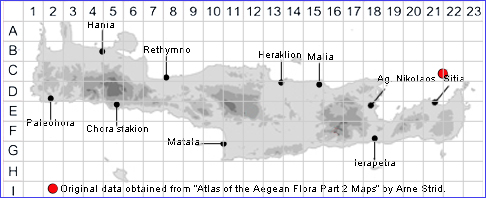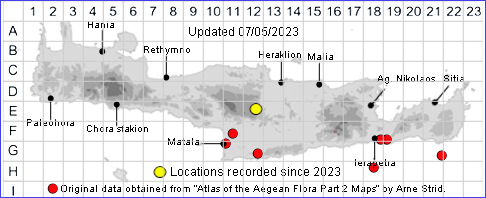~~~~~~~~~~~~~~~~~~~~~~~~~~~~~~~~~~~~~~~~~~~~~~~~~~~~

SILENE APETALA
Including Silene Alexandrina
Family:- CARYOPHYLLACEAE/Sect. DIPTEROSPERMAE
Common Names:- None
Synonyms:- Viscago aspera.
Meaning:- Silene (Gr) A name used by the Greek philosopher Theophrastus for
catchfly.
Apetala (Gr) Without petals.
General description:- Whole plant pubescent.
Stems
1) 10-35 cm, erect, branched, especially at the base.
Leaves:-
1) Lanceolate to linear-lanceolate; upper ovate-lanceolate. Lower pedicels as long
as or up to 3 times as long as the calyx.
Flowers:-
1) Calyx, 7-10 mm, ellipsoid-cylindrical, becoming broadly campanulate in fruit.
2) Calyx-teeth, triangular, acute.
3) Petals absent, or included in the calyx, or exserted.
4) Petal-limb, bifid up to c. 3 mm.
Fruit:-
1) Capsule, 6-7·5 mm; carpophore 1-2 mm.
2) Seeds, 1 mm or less, dull blackish-brown.
Key features:-
1) Carpophore less than 4 mm.
2) Petals often absent
Habitat:- Rocky limestone slopes with dry open shrubby vegetation, field margins,
wasteground, paved courtyards. 0-300(950) m.
Distribution:- In Greece not reported outside the Aegean area, but inconspicuous
and perhaps overlooked. - Scattered in the Mediterranean region and SW Asia.
Rare on Crete currently known only from the island of Dragonada in the NE.
Flowering time:- Mar-May.
SPECIES DESCRIPTION
SILENE ALEXANDRINA
Synonyms:- Silene apetala var. alexandrina
Meaning:- Silene (Gr) A name used by the Greek philosopher Theophrastus for
catchfly.
Alexandrina (L) This taxon was originally described from Alexandria,
Egypt.
Resembling Silene apetala, but differing in the following characters:
1) Plant small and slender.
2) Calyx veins conspicuously pilose, often reddish.
3) Petals longer than the calyx, pink.
Habitat:- Loamy coastal flats, Lygeum steppe, dry open shrubby vegetation,
archaeological sites, 0-100(400) m.
Distribution:- In Greece not known outside the Aegean area. - Also Cyprus,
Palestine and Egypt, perhaps further distributed in the SE Mediterranean area, but
confused with S. apetaia. Rare on Crete currently known only from a few southern
coastal locations.
Flowering time:- Feb-Mar ‘
Photos by:- Zacharias Angourakis & Dorothea Hege

